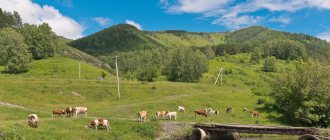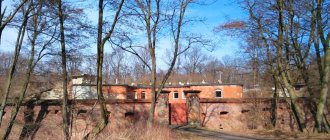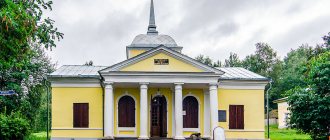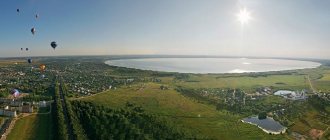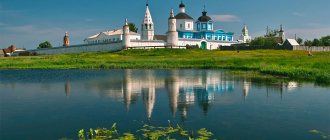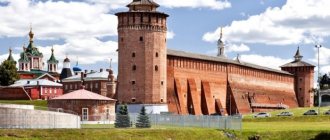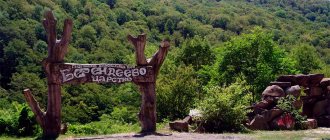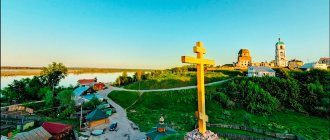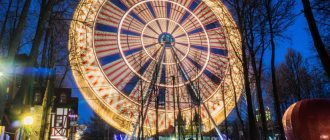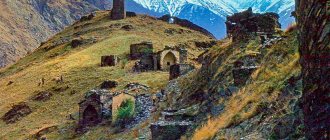The Volga Federal District, as the name implies, stretches along the banks of the longest river in the European part of Russia - the Volga. It is not the largest in territory, but in terms of population it is in second place after the Central District. A fifth of all Russians live here. The Volga region is a link connecting the Urals and the central part of Russia. The Volga Federal District has everything that nature is rich in: coniferous and deciduous forests, steppes and mountains, rivers and lakes. The endless variety of landscapes and rich history of these places will not leave anyone indifferent.
Volga is the main water artery of the Volga Federal District
Volga cruise
Perhaps there is no better way to see all the beauty of the Volga region than a river cruise. Such a journey involves constant movement, frequent changes of places, and getting to know new historical cities. On your way you will see Uglich, Kostroma and Ples, Nizhny Novgorod and Kazan, Volgograd and Saratov, Ulyanovsk and Cheboksary, the Mari city of Kozmodemyansk and the ancient Russian Yaroslavl.
View of Cheboksary from the Moscow Bridge over the Cheboksary River
Green parking lots in Usovka and Akhtuba will help you get to know the nature of the Volga region better. You will enjoy the majestic expanse with low hills and gray cliffs surrounding the flowing wide river. And behind the settlements scattered in the fields, poetic oak forests begin. Here you feel the presence of an endless source of inspiration and impressions, you are constantly under the spell and find yourself captive of creative ideas.
Ski holidays in Abzakovo
The Abzakovo ski resort is one of the best in the Ural Mountains. Perhaps the local service cannot be compared with the European one, but the prices here are not bad, and the resort is very compact and functional. From the hotel complex, where there is a small but cozy indoor water park, you can climb straight to the top, where the resort's pistes begin.
Abzakovo is one of the most well-equipped ski resorts in Russia
You can get to the foot of the slopes by car or minibus: there are cafes and shops, as well as a small but quite impressive zoo with bears and tigers. Abzakovo is suitable for families with children: in 2011 it was recognized as the best resort in Russia for families and children. There are simple trails, children's instructors, and a special baby lift. There are also many adult trails here. Depending on the difficulty level, they are divided into red, green and blue.
After skiing, you can go to the bathhouse or sauna, and on a free day, go on a helicopter excursion or visit Magnitogorsk.
Weekend in Kazan
Kazan is a much more interesting city than it might seem at first glance. It has absorbed the characteristics of Eastern and Western cultures, so it looks like an ancient Russian city, but with a pronounced oriental flavor. Once here, first of all visit the Kazan Kremlin and the Kul Sharif Mosque.
Afterwards, stroll along the wide central streets of the city, visit the National Museum of the Republic of Tatarstan and the Musa Jalil Apartment Museum.
Panoramic view of the Kazan Kremlin and the Kul Sharif Mosque
Then go to the building of the architect Ildar Khanov, called the Temple of All Religions. It combines a Christian cross, a Muslim crescent, a Star of David and a Chinese dome.
Also go to the Blue Lakes, fed by water from underground springs. The transparency of the water in them is about 40 m. The whole day can be devoted to entertainment in the largest water park in Russia and one of the largest in Europe, “Riviera”, located in Kazan. It has more than 50 different attractions that can captivate not only children, but also adults.
Test
in tourism regional studies
on the topic: “HISTORICAL SIGHTS OF THE VOLGA REGION”
Plan.
Introduction
1. About some historical sights of the Upper Volga region
2. Nizhny is my homeland. Monuments and legends
3. From the history of the “pocket of Russia”
Conclusion
List of used literature
Introduction
The Volga region is one of the largest in Russia. It includes the Astrakhan, Volgograd, Kuibyshev, Penza, Saratov, Ulyanovsk regions, Kalmykia, and Tatarstan. The Volga region is a territory adjacent to the middle and lower reaches of the Volga and economically gravitating towards it. There are an elevated right bank (from the Volga Upland) and a low-lying left bank (the so-called Trans-Volga region. In natural terms, areas located in the upper reaches of the Volga are also sometimes referred to as the Volga region. Since ancient times, the Volga has been and remains an important waterway that connects not only industrial areas, but also cultural centers. For regional studies, everything is important - from a cultural monument to the latest original technologies. Of course, in an abstract it is impossible to consider in detail even the main historical attractions of the Volga region. For example, the great writers A. N. Ostrovsky, N. A. Nekrasov, A.M. Gorky, artist I. Levitan and many other creative personalities, it was in the Volga city that the first theater in Russia appeared.
The purpose of the presented work:
1. Study the main monuments of the Upper Volga region.
2. Explore a number of historical aspects of the Nizhny Novgorod Fair.
3. Get to know the monuments and legends of Nizhny Novgorod more deeply.
I chose these questions to study because I am convinced that each of us should know the history of the country and especially of our small homeland.
IN. Klyuchevsky very accurately noted: “The subject of history is that in the past that does not pass away as an inheritance, a lesson, an unfinished process, as an eternal law.” This idea of the famous scientist can easily be attributed to regional studies.
1. About some historical sights of the Upper Volga region
Uglich is the city of Tsarevich Dmitry.
The small quiet ancient Russian city of Uglich is located in the Yaroslavl region. It is located on the banks of the Volga River, just at the place where it makes a sharp bend, which was once called “Ugilets” or “Uglich”. Maybe that's why the city has such a name. According to another version, coal was burned at this place in ancient times.
The sound of the city’s name evokes memories of the tragic story of the 16th century associated with the murder of Ivan the Terrible’s son, Tsarevich Dimitri, reproduced by A. S. Pushkin in the drama “Boris Godunov.”
Witnesses of great historical events and changes - architectural monuments of the 17th-18th centuries, preserved to this day - can tell us about the distant past of the city. This is, first of all, the Uglich Kremlin, located in the center of the city, the territory of which is limited from the north by the Volga, and from the east and west by the Kamenny Brook and the Shchelkovka River. Here are the “Chambers of Tsarevich Dimitri” (XV century); Church of Demetrius on the “Blood” (XVII century) - at the site of his death; Spaso-Preobrazhensky Cathedral (XVIII century) and other buildings.
Unique architectural monuments can be seen in other areas of the city. Not far from the center of Uglich, the Assumption Church of the Alekseevsky Monastery (XVII century) attracts attention with the silhouette of its beautiful high tents “Wonderful”.
In general, a lot of monasteries and churches have been preserved in Uglich and its environs. The highest point of the city is Krasnoarmeysky Boulevard, from which a majestic panorama of the Volga region and wonderful views of the Uglich Kremlin and the Resurrection Monastery open.
Yaroslavl is a treasury of Russian culture.
In the precious necklace of ancient Russian cities, Yaroslavl shines with a particularly bright, unfading light. The city was founded in 1010 by the Rostov prince Yaroslav the Wise on the site of the village of Medvezhiy Ugol at the confluence of the Kotorosl and Volga rivers and had the task of protecting the route from the Volga to Rostov the Great - the main city of Zalesye. Yaroslavl was first mentioned in the chronicles in 1071. At the beginning of the 13th century, thanks to its favorable geographical location, Yaroslavl became one of the large cities of the Rostov land and soon became the capital of an independent principality.
By the 18th century, Yaroslavl was a large trade and craft center, where stone construction was carried out, original schools of stone architecture and wall paintings were emerging, crafts were flourishing, and the manufacturing industry was developing.
Perhaps in no other city is the architecture of the 17th century, which became the “golden age” of Yaroslavl, so clearly represented: the Church of Elijah the Prophet, the Church of the Epiphany, the buildings of the Transfiguration Monastery (founded at the end of the 12th century), etc.
Modern Yaroslavl is a regional center of Russia, a port on the Volga River. Population - 630 thousand inhabitants. Yaroslavl tires, diesel engines, synthetic rubber, varnishes and paints are well known on the Russian commodity market. The city has 5 universities, 3 theaters, a circus, a philharmonic society, a Historical and Architectural Museum-Reserve, an Art Museum, singer L.V. Sobinova.
Kostroma is the cradle of the Romanov dynasty.
Driving over the long new bridge over it, you involuntarily feel like a poet: “Oh, Volga! My cradle..." From the bridge there is a panoramic view of Kostroma with its famous Trading Rows. Domes of churches and bell towers. And here is the pier where the “Swallow” of Nikita Mikhalkov’s hero moored in the film “Cruel Romance”. In the distance are the golden domes of the Ipatiev Monastery Cathedral, and next to the bridge are the green domes of the marvelous Church of the Resurrection on Debra.
In Kostroma, everything is unusual: locals call the central square “Skovorodka”, on it stands the first monument in Russia to the peasant hero Ivan Susanin, and the monument to Lenin on the Volga slope is on the majestic pedestal of the Romanovs. Looking at the fire tower, which you will not find in all of Russia, you involuntarily think with an involuntary smile how the city treated its fire chiefs, since this elegant tower was erected like an empire-style temple, a palace.
When you get acquainted with the monuments of the city, famous names come to life - Ivan Susanin, Mikhail Romanov, Boris Godunov, literary characters of A. Ostrovsky. The Museum of Nature presents a unique collection of beautiful butterflies and bugs from all over the planet, striking in incredible colors and sizes.
The Kostroma Trading Rows, in contrast to the Suzdal, Yaroslavl, and Vladimir ones, reflect the true scope of the Russian merchants, to whom A.N. dedicated his work. Ostrovsky.
But the special significance of Kostroma for the history of Russia is the calling to the throne from the Ipatiev Monastery of Mikhail Romanov, who laid the foundation for a new dynasty of Russian monarchs.
Plyos is a town dear to the heart.
A reach is a section of a river bed that is deeper than those located above and below. Thanks to its special topography, the city of Ples was founded as a border outpost of the Moscow principality in 1410 by Prince Vasily, the son of Dmitry Donskoy. The fate of Plyos was difficult. Its conquerors mercilessly ravaged it, and it burned to the ground in fires. But it was rebuilt again and delighted people with its fabulous appearance. During the time of Ivan the Terrible, the city was for a long time listed as a major supplier of fish for the royal court, and by the end of the 18th century, Plyos was already known as a famous marina, “beautifully arranged by nature itself.”
The city is famous thanks to the works of the Russian artist I.I. Levitan, who lived in Plyos in 1888-89. Next to the Museum of I.I. Levitan on the banks of the Volga there is a monument to the artist (sculptor N.V. Dydykin). Based on subjects found during the artist’s trips to Plyos, Levitan painted about forty paintings. Let's name the most famous paintings: “Evening. Golden Reach", "After the Rain. Ples”, “Quiet Abode”, “Evening Bells”, etc.
In the 20s of the 20th century, Plyos turned into a health resort town. Now there are rest houses, boarding houses, and tourist centers here. The unity of nature and modest architecture of the 19th century is striking in its integrity, poetry and uniqueness. People fall in love with this town at first sight and forever.
2. Nizhny is my homeland. Monuments and legends
Nizhny Novgorod can safely be called a city of legends and traditions. They are connected with many events in Nizhny Novgorod history. This is the legend our fellow countryman, writer P.I. Melnikov-Pechersky, tells about the emergence of Nizhny Novgorod in “Essays on the Mordovians”:
“Because of the Kudma River, the Mordvin Abramka came to the mouth of the Oka and settled on the Dyatlov Mountains, overgrown with dense forest. He had fourteen sons and three daughters, and Abramka built seventeen houses, where the local story indicates where the bishop's house is now located. This Mordovian village was called “Abramov,” and Abramka was a “punk,” that is, the ruler of neighboring Mordva (Teryukhan). When the Russians began to prepare for the first campaign against Mordva, Abramka fortified his town, surrounded it with a tine and ramparts; there were then up to five hundred people in it. In his town, Abramka built two gates: one on the south side of the rampart, wide, with oak mortars, and covered them with earth; others - Tainitsky, at the Cow's Wagon, to the north, from which they went to the Volga for water.
The Russians approached Abramov’s town, numbering fourteen thousand, and began to talk with Abramka:
“Get away from the mouth of the Oka and give our prince tribute.”
“I’m not a Mordovian prince, but only an elected “punk,” answered Abramka. - the Mordovians will not listen to me, but I will gather all the Mordovian people, talk to them and persuade all of Mordovians to submit to the Russian prince; just give me four years.
“I won’t give you four years,” answered the Russian “Murza,” “but I give you four days.”
Abramka agreed, notified the nearest Mordovians, and in two nights five thousand Mordovians poured into his town through the Tainitsky Gate. On the fourth day of the agreed period, Abramka ordered to dig up the gates covered with earth, and the Mordovians attacked the Russian army. But the Russians prevailed, took possession of the town, burned it, plundered it, and captured the inhabitants who were beaten. Abramka himself was killed.
The Russians set up their town not in the place where the Abramovo settlement was, but upstream of the Oka, in a place that is now opposite the fair bridge. Mordovians, having learned about the death of the punk Abramka, and that his city at the mouth of the Oka was occupied by the Russians, became worried, and six thousand Mordovian warriors gathered to avenge the death of their “punk” and drive the Russians out of their land. There were only a thousand Russians. Having learned about the approach of Mordovians, they came out to meet them and fought with them near the village of Novaya, otherwise Shcherbinka, made their way through the Mordovian hordes and left for Vladimir through Berezpolye. The Russians were on horseback, and the Mordovians were on foot, which is why they could not reach the fleeing Russians. Having learned about this, the Russian Grand Duke himself moved to Mordva and, having taken possession of their coastal areas, founded Nizhny Novgorod.”
Several famous legends are associated with the Nizhny Novgorod Kremlin. A number of its towers have names given according to legends. For example, the Koromyslovaya Tower. This round tower is located on a sharp turn of the Kremlin wall above the intersection of the Zelensky Congress (“pipe”) with the Pochainsky ravine. From here began a noticeable and today gentle descent to the Pochayna River; along the path along the slope of Nizhny Novgorod they carried water on rocker arms. And the tower itself with its adjacent spindles resembles, when viewed from the opposite bank of the Pochainsky ravine, a strong young woman with rocker arms on her shoulders. Isn’t that why the tower is called Koromyslova?
True, legends offer us other options for the origin of the name of the tower. In 1520, the Kazan king Saip-Girey, after a three-day siege of Nizhny Novgorod, as the ancient chronicle says, “having done nothing, it’s a shame to turn back,” in other words, after an unsuccessful offensive, he retreated. The fortress of the Kremlin walls, like more than once before, saved the city.
Nizhny Novgorod was besieged by countless enemy forces. Day after day, the people of Nizhny Novgorod fought off the heavy attacks of the enemy, and their strength began to melt away. The city was running out of food supplies, and most importantly, there was not enough water. The defenders began to think that they would have to surrender to the mercy of the winner. Among the besieged there was one brave girl. She volunteered to bring water from the Pochaina River. Early in the morning, under the cover of fog, they lowered her from the wall. She carefully passed the Tatar patrols, went down to Pochayna, drank herself, took full buckets of water and began to climb the steep mountain with them. And friendly hands were already close, ready to pick her up, when a Tatar patrol appeared. The enemy raised the alarm. A fierce battle ensued between the Tatars and the girl, in which she defended herself with her yoke. The girl killed several Tatars with it, but she herself was killed. The girl’s bravery confused her enemies. They reasoned: “If there are such brave women in this fortress that one of them killed several of our soldiers without a weapon, then what kind of men should they be?” The siege was lifted. The murdered girl was buried with honors under the tower, along with buckets and a rocker. Since then that tower has been called Koromyslova.”
The content of another most famous version of the legend boils down to the following: “In Nizhny Novgorod, masons began to build the Kremlin. The next morning they came and saw that everything they had done had fallen apart. The masons were surprised, shook their heads, but continued working. And the next day they saw everything falling apart again. The masons decided to turn to the old men for advice. And the old men said: in order for the Kremlin to be strong, durable and not be taken by enemy forces, it must be built on the blood of the first living creature to approach the construction site.
Not far from the place where the Kremlin was built, there lived a townsman. And he had a young wife, the beautiful Alena, who was expecting a child. That morning Alena went out early on the water to the Pochaina River. She took buckets and a rocker, went down to the river, picked up full buckets and began to climb the steep mountain with them. And Alena saw that people were standing near the site of the Kremlin and were waiting for something. Alena approached the builders. The gray-bearded boyar waved his hand. They grabbed Alena and walled her up alive under the base of the tower. Along with it they put buckets with a rocker there. Since then, the Koromyslova Tower began to be called. And Alena's husband. Having learned about the terrible death of his wife, he committed suicide and rushed into the Volga.”
But what legend exists about the Northern Tower of the Nizhny Novgorod Kremlin. The tower had another name - Ilyinskaya, after the church of the Old Testament prophet Elijah, built, according to legend, on the spot where Murza Nogaisky, the Tatar prince, was killed: on the side of the Pochainsky ravine opposite the Kremlin.
In September 1505, hordes of Tatars and Nogais numbering about sixty thousand besieged the Nizhny Novgorod Kremlin.
The Nizhny Novgorod governor Khabar Simsky had both cannons and gunpowder at his disposal, but he did not have craftsmen - gunners from local soldiers. And in the city dungeons at that time, captured Lithuanians languished - the fiery archers. They were captured in 1500 after defeat in the battle of the Vedrosha River, which flows into the Dnieper near Dorogobuzh. Along with the prisoners, captured guns were also delivered to Nizhny. The governor promised the prisoners freedom if they helped defend Nizhny. With the first cannon shot, the legendary Fedya Litvich hit Murza Nogaisky, and the Tatars retreated in confusion. The chronicle says that the Lithuanians, with their fiery shooting, kept the city from being taken, and delivered the people from the sword and captivity. Khabar Simsky kept his word and not only released him, but also richly rewarded the Lithuanian archers, many of whom remained in Nizhny of their own free will.
And one more Kremlin legend - about the St. George Tower.
According to biblical legends, the young military leader George, during the persecution of Christians by the Roman emperor Diocletian (III-IV centuries), began to profess Christianity, for which he was beheaded. In Rus', St. George has been revered since the first years of the baptism of Rus'; his name was given to members of grand ducal families; the Cross of St. George is an honorary award for many generations of Russian soldiers. The name of the Grand Duke, the founder of Nizhny Novgorod, was also George.
But what legend exists about Kozma Minin. In the “Book of the Miracles of St. Sergius,” written by Elder Simon Azaryin, there is a story “About the appearance of the wonderworker Sergius to Kozma Minin and about the meeting of military men to cleanse the state.”
In the bitter time of unrest, “the pious man of Nizhny Novgorod named Kozma Minin... The wonderworker Sergius appeared to him, commanding him to collect the treasury and allocate military people and go to the cleansing of the Moscow State.”
Kuzma Minin was a poor man, engaged in small trade in meat and fish, “a wretched purchase,” “the husband is not famous by birth,” the chronicler says about him, “but he is wise in meaning.” Enjoying great popularity among the people and distinguished by exceptional honesty, Minin was elected zemstvo elder by the Nizhny Novgorod townspeople on September 1, 1611. Nizhny Novgorod residents unanimously entrusted Minin to judge and sort out their disputes, lead them, and resolve their public and worldly affairs. Let us recall the famous painting by K. Makovsky “Minin’s Appeal to the People of Nizhny Novgorod,” which is kept in the Nizhny Novgorod Art Museum.
On the roads of Mari El
Between the industrial cities of the European part of Russia, on the busy, navigable Volga, a wonderful corner of untouched nature has been preserved, the most ecologically clean region of Russia - the Mari El Republic.
Embankment of the Kokshaga River in the city of Yoshkar-Ola
Its main attraction is the mysterious and enigmatic forests in which centuries-old oak trees grow and bears, moose and hares live.
Arriving in the capital of the republic - Yoshkar-Ola, take a walk along the embankment of the Kokshaga River, visit the National Art Gallery and the Tsarevokokshay Kremlin complex, which is an architectural ensemble of churches and fortress walls with towers and gives an idea of the medieval Russian fortress.
Afterwards, head to the Mari Chodra National Park. There, go to Sea Eye Lake. It got its name due to the turquoise color of the water and its unusual shape. For the residents of the republic, the forest is an open-air temple. The altars of the natural sanctuary are countless lakes, most of which are located in the Mari Chodra National Park. You can admire them at any time of the year.
A short trip to the Shulgan-Tash cave
The Bashkir land is rich in natural wonders, but the main one is caves. Each of them is unique and keeps some secret. There are also record holders here: the deepest cave is Pobeda and the longest is Sumgan. But the queen of the caves of Bashkortostan, of course, is the multi-story Shulgan-Tash, also known as Kapova Cave. Its structure will not leave anyone indifferent.
Ural Mountains and Belaya River
The cave has three tiers, the entrance to it is represented by a huge arch. Only the first and partially second floors of this place have been studied. To get here, you will have to take a short boat trip along the Agidel, or Belaya, river from Ufa, or rather from the village of Starosubkhangulovo, to the cordon of the Shulgan-Tash nature reserve. Once there, visit the Kaban-Tash rock and the Skazka or Akbulatovskaya cave.
Go to the tourist and excursion complex of the Shulgan-Tash nature reserve.
Visit the Onboard Beekeeping Museum and the Nature Museum. And then you will have an excursion to the Shulgan-Tash cave.
Pavlov's House
It is famous for the fact that it was here that a group of Soviet soldiers defended themselves against German troops for 58 days. It got its name from the surname of Sergeant Ya. F. Pavlov, the leader of the reconnaissance group that occupied the house.
Subsequently, Pavlov's house became the first to be restored in post-war Stalingrad. For the edification and memory of descendants, a memorial wall made of “native” material with traces of bullets and shells was erected at the end of the building.
This landmark of Volgograd is a symbol of courage and perseverance. On the memorial wall there is the inscription “In this house, military and labor feats merged together.”
Excursion around Nizhny Novgorod
The architecture of this city is called frozen music. On the streets of Nizhny Novgorod you can find the heritage of five centuries of Russian history. The most ancient building of the city, considered an example of Russian fortification architecture, is the Nizhny Novgorod Kremlin. Situated on the high bank of the Volga, this amazing architectural example is the main historical monument and the center around which city life developed. It is from here that ancient streets, famous for their architectural treasures, diverge like rays in different directions.
Confluence of the Oka and Volga
Nizhny Novgorod seduces with its combination of provincialism and comfort. It stands on the spit of the Oka and Volga, from its embankments and bridges there are stunning views, the main characters of which are the flowing Oka, the wide Volga and the Alexander Nevsky Cathedral.
Kazan Kremlin
Created in the 10th century, but rebuilt many times. It has stood in its current form, with some modifications, since the 16th century. Played a significant defensive role. The towers are very different from each other. There are well-preserved places , partially reconstructed, some of the buildings have been lost. The perimeter of the walls contains: the representative office of the President of Tatarstan, galleries, a mosque, churches, and a number of museums.
Vacation in the Orenburg region
The Orenburg region is located in the foothills of the Southern Urals. It is a kind of geographical bridge, a border area between Europe and Asia. The border between the two parts of the world runs along the Ural River, which flows through the administrative center of the region - the city of Orenburg. However, the Orenburg land is located not only on the border of parts of the world, but also at the junction of forest and steppe, mountains and plains. This land is overflowing with natural wonders, some of which humans have had their hands on.
Embankment of the Ural River in Orenburg
Start your journey by getting to know Orenburg.
Take a walk along the embankment of the Ural River, go down to the water, walk through the city center, where there once was a fortress. Go to the city of Buzuluk, walk through the local forest and look at the most beautiful building in the city - the former women's gymnasium.
Visit Orsk and look at the Guberlinsky Mountains, which are not mountains at all, but no less beautiful for that, swim in the warm waters of the Iriklinsky Reservoir. Take a week to relax in Sol-Iletsk, where you can improve your health and feel young and vigorous again. Don’t forget to buy a traditional souvenir of these places - an Orenburg down scarf.
Visit to Saransk
Having begun its history in 1641 as a small fortress on the way from Astrakhan to Moscow and from Crimea to Kazan, today Saransk has turned into the capital of race walking and one of the most comfortable cities in Russia. This is a small city in which life flows slowly and measuredly, which allows you to take a break from the bustle of megalopolises.
Take a walk through the central part of Saransk, bounded by the streets of Respublikanskaya, Botevgradskaya, Polezhaeva.
Saransk railway station
Visit St. Fedorovsky Cathedral, the Church of the Three Hierarchs and the Church of St. John the Evangelist. Check out the local history museum and the Museum of Mordovian culture. Explore the monuments of Saransk. The city contains the only monuments in Russia to Patriarch Tikhon and Emelyan Pugachev.
Also here you will find a monument to astronauts and poet A.I. Polezhaev.
Visit the Fox Bridge, make a wish and rub the nose of the cute fox - the symbol of the city, then everything you wish will definitely come true. And as a souvenir of your trip to Mordovia, buy an old local souvenir - wicker bast shoes.
Weekend in Solikamsk
The name of the city itself suggests the reason for its appearance. The city was founded in 1430 on the banks of the Usolka River, one of the tributaries of the Kama, where salt was evaporated at that time. In the 20th century Large deposits of potassium salts were discovered here, thanks to which Solikamsk turned into the salt capital of Russia.
Epiphany Church in Solikamsk
Today it is the third largest city in the Perm region. Start your “salty weekend” with a visit to the unique Salt Museum, which is located in the buildings where the Ust-Borovsky salt plant operated until 1972.
In addition to salt deposits, the city is famous for its many ancient churches.
Visit the main temple of Solikamsk - the Trinity Cathedral, as well as the Epiphany and St. John the Baptist churches, the latter of which resembles a sailing ship.
Look at the falling Cathedral Bell Tower - an architectural monument of the 18th century. and the Voivode's House, the walls of which are about two meters thick. Plan your trip to visit the festival of blacksmithing “Fires of Hephaestus”, which takes place in Solikamsk every summer.
Gerhardt's Mill
Without knowing the history of the Gerhardt mill, it is difficult to believe that this is a dilapidated brick building on the street. Marshala Chuikov is a landmark of Volgograd.
However, this mill, like Pavlov’s House, turned out to be an insurmountable barrier for the fascist troops. A small group of Soviet soldiers held the defense there for 58 long days.
In the post-war years, the Gerhardt mill was not restored, but was preserved in a dilapidated state in memory of the events that took place. Its walls are riddled with traces of bullets and military weapons, the roof has collapsed, and there are gaping holes in the ceilings.
Until recently, the inscription “Gerhardt”, the surname of the owner of the mill, was visible on both ends of the building. However, in the spring of 2021, a fragment of brickwork collapsed, and the inscription on the southern end was lost.
Five days in Saratov
Saratov stands on the high bank of the Volga and is surrounded on all sides by low mountains, which determines the appearance of the city and its microclimate. It is one of the twenty largest cities in Russia and for a long time was the unofficial capital of the Volga region. While here, visit the planetarium, circus, ethnographic museums, theaters and art galleries, as well as the house-museums of Radishchev, Chernyshevsky, Kuznetsov, Borisov-Musatov. Saratov is famous for the Saratov meteorite, which fell near the city in 1918, as well as the landing site of Yu. A. Gagarin, which is located 16 km south of the city of Engels, connected to Saratov by a beautiful bridge over the Volga. While in Saratov, spend a day visiting Sokolovaya Mountain, where the Victory Park memorial complex is located, which includes the Museum of Military Equipment and an ethnographic village.
The Saratov Bridge at the time of its opening in 1965 was the longest in Europe
Devote another day to walks through the Kumysnaya Polyana forest park, located on the Lysogorsk plateau. There are springs, walking paths, and several health resorts, sanatoriums and ski resorts.
Main monuments and memorials of the Volga region
- Gagarin's landing site in Engels;
- Monument to the salt-carrying bull in Engels;
- Monument to Izhik in Izhevsk;
- Mamaev kurgan;
- Monument to Friendship of Peoples in Izhevsk;
- Monument to Yuri Gagarin in Orenburg;
- Monument of Devotion in Tolyatti;
- Monument to the Kazan cat;
- Monument to Catherine II's carriage.
Holidays in Samara
Sun, Volga, fish, beer... This set of pleasures is guaranteed during a trip to Samara. This city is especially beautiful in summer. A walk along its wide streets and the Volga embankment, the longest in Russia, will give you a lot of positive emotions. Samara is the heart of the Volga region.
The length of the embankment in Samara is about 5 km
Go on a boat ride along the Volga, visit Stalin's bunker, covered in legends, see Samara Square, the Lutheran Church, and Klodt's mansion.
Afterwards, head to Togliatti, a Russian motor city. Check out the monument to Vasily Nikitich Tatishchev - one of the symbols of the city, located on the observation deck with an excellent view of the Volga.
Go to the visiting card of Tolyatti - the AvtoVAZ plant management building with the AvtoVAZ boat rotating on it.
If you come to Togliatti in July, you can take part in the famous Grushinsky festival, held in the suburbs. And if you find yourself in Samara in June, you can visit the largest one-day rock festival in Europe - Rock over the Volga, which takes place on the 12th day of the first month of summer.
The Volga region has many museums and cultural centers that are worth visiting for tourists
- Puppet theater "Ekiyat";
- Saratov Conservatory;
- Panorama Museum "Stalin's Battle";
- Sculpture Park “Legend”;
- Museum-Reserve "Tarkhany";
- City Chess;
- Museum-reserve "Motherland of V.I. Lenin";
- Museum-Reserve of A. S. Pushkin “Boldino”;
- Samara Space Museum;
- AvtoVAZ Museum in Tolyatti;
- Mari Ethnographic Museum;
- Museum I.V. Stalin;
- Museum of Musical Instruments of E. N. Pushkin;
- Shamil's House;
- Museum of Steam Locomotives of Russia;
- Saratov automobile bridge.
The Volga region is rich in history, which it is ready to share with all guests.
The Volga region will pleasantly surprise lovers of nature, culture and entertainment. Every year cities improve. And museum collections are replenished. And memorable photos against the backdrop of the sights of the Volga region will come out bright and impressionable.
Weekend in the Kirov region
The Kirov region is impenetrable forests rich in berries and animals, picturesque water meadows worthy of the brushes of famous landscape painters, calm rivers, and clear lakes. The Vyatka River, considered the main river in the region, gave this land another name - Vyatka Territory. These places are rich in historical and architectural monuments; they offer endless opportunities for educational, ecological and extreme recreation. Stay in Kirov and get to know this interesting city better.
Visit the Cathedral of St. Seraphim of Sarov and the Assumption Trifonov Monastery.
Assumption Trifonov Monastery
Visit the paleontological museum, the house-museum of the writer M. Saltykov-Shchedrin and the Vasnetsov Art Museum.
Take a walk along the embankment of the Vyatka River, the largest tributary of the Oka. Take a trip to the Vyatka natural wonder - Lake Shaitan, famous for its drifting islands and water emissions in the form of fountains.
Go to Lake Lezhninskoye, whose clean and clear waters are loved by divers. And as a souvenir of the trip, buy yourself a funny whistle - a Dymkovo toy, which has long become a symbol of the Vyatka region.
